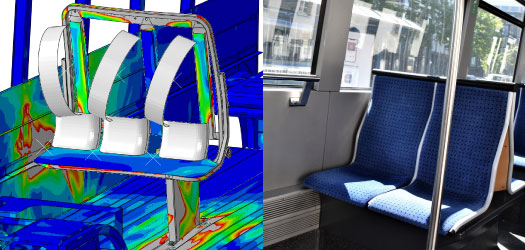Key Benefits:
- Virtually validate standard tests before manufacturing a prototype
- Cost and time reduction
- Realize design changes at the early (virtual) stage
New vehicle manufacturers must comply with several standards, one of them in North America is FMVSS210 for seat belt anchorage, ensuring proper location for occupant restraint and preventing their failure.
This test requires pulling on seat belts with specific forces and at specific locations representing a person in the seat supporting an impact. This test is usually done with a physical prototype in certified test centers.
The best way to make sure these expensive tests will pass the test is to simulate them virtually using Finite Element Analysis during the design phase. ABAQUS explicit solver is used to realize this type of analysis.
The image shows stress results in the seat and vehicle structures at some point in time during the pull test. In addition to stresses, bolts and rivets forces are evaluated to predict the pass or failure of the test. In this case, the customer was able to modify the design of the attachment regions to improve local rigidity and pass the test.
Leveraging the simulation technologies in such an application allows for saving significant time and money since failing a physical test is very costly both in time and money. Better to validate tests early in the virtual world where design changes are easy and quick to do.

